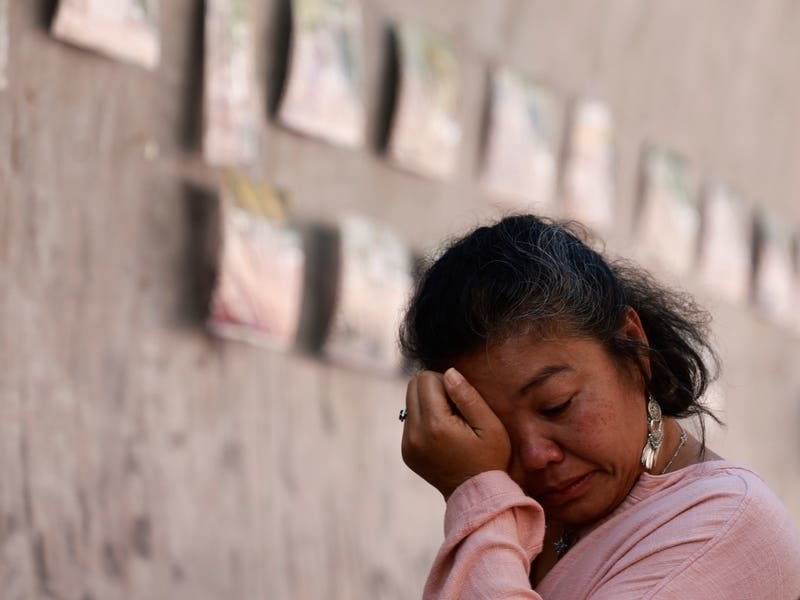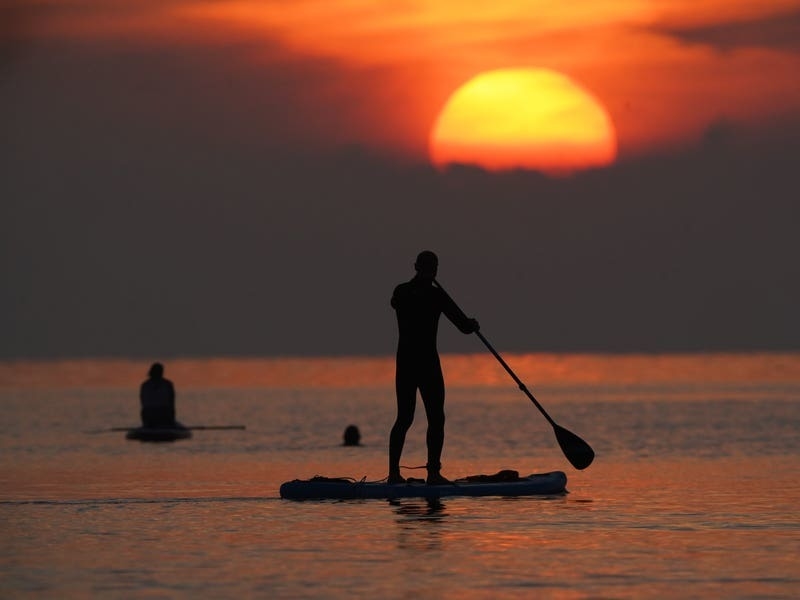NOVEMBER 1975 began with Art Garfunkel’s single I Only Have Eyes For You topping the charts. A young art college graduate named Peter Mourant could not have known it at the time, but the song’s title would encapsulate the narrative of his distinguished career.
That’s because Peter, who began work at the Jersey Evening Post on 11 November 1975 as a 22-year-old photographer, has remained steadfastly loyal to the newspaper.
‘It seems incredible that I’ve been here for over 42 years, but I’ve enjoyed my time at the JEP enormously,’ says Peter (64), who will be retiring from his role as the JEP’s picture editor on Tuesday.
‘I can hardly think of a day when I haven’t wanted to come into work. It’s down to the nature of the job which is so varied – you literally don’t know what the day will bring or how it will end.’
He vividly recalls the first picture he took as a fresh-faced photographer for the JEP.
‘It was a fantastic picture of a traffic island at the end of the Albert Pier – they didn’t start me with anything too ambitious.’
Until 1977 – when the JEP moved to its current location at Five Oaks – the newspaper’s offices were located in town.
‘The JEP was in Charles Street and the photographic offices were up a creaky staircase right at the top of the building – it was like a Dickensian garret. I’d come from studying at a brand new arts college – Salisbury College of Art – and I found it a bit of a shock.
‘The office atmosphere was very different back then. There was a lot of cigarette and pipe smoke, you could hear the clatter of typewriters, and our black and white films were developed in deep vats of chemicals which had a distinct smell.
‘And down in the press room the compositors were typing out on hot metal. The whole thing was a much noisier and more physical process than it is today.’
This was the era of photographic darkrooms in newspaper offices, and Peter remembers how the JEP’s was a place of sanctuary for photographers immersed in their craft.
‘The darkroom was bathed in a subdued orange light and it intimidated other people. They would have to go through
blackout curtains to get in and I can remember the editor at the time, Mike Rumfitt, coming into the office and asking, “Is Peter around?”
‘Somebody replied, “He’s in the darkroom” and Mike said, “Oh, all right, I’ll come back later” – there was a feeling he really didn’t want to go in there.
‘Certainly, when there were big events on like the Battle of Flowers, it was pretty frenzied in there.’
In that period, the process of taking and making pictures was not always straightforward, as Peter can attest to.
‘With film there were more opportunities for something to go wrong. You could forget to put the film in the camera entirely – which happened to me once. There were also the pitfalls of something going wrong with the thermostat of the chemicals, which meant your film would be ruined.’
Peter, who was born and raised in Jersey, admits it took him a while to get his bearings on his return to the Island after art college in England.
‘Although I had lived in Jersey all my life, as a young man there were lots of places I’d never been to before and I was like somebody who had come over from England for the first time – I got lost quite a lot on work assignments.’
He may have taken a few wrong turns in his JEP-issued Mini, but he quickly found his feet as a talented photographer who did much to enhance the newspaper’s pictorial offering.
‘I pushed to get more interesting photography in the newspaper. Photography had a much lower priority at the JEP when I joined than it does now. Quite often, the front page had no picture on it.’
It wasn’t long before he was putting more than a mere camera’s flash of creativity onto the news pages.
‘I went with a reporter to photograph the retirement of the last lighthouse keeper at Corbière Lighthouse in February 1976. I took various photographs of the lighthouse keeper, Mr Fred Hobbs, and one of them was just his back view, looking back towards the lighthouse.
‘I thought that was much more evocative of the story, but it took a lot of persuasion to convince the chief sub to use a photograph of someone who was retiring without actually showing his face.’
Peter’s efforts to make interesting and varied pictures a prominent part of the newspaper paid off.
‘We’ve come a long way from the handshake, handing-over-the-charity-cheque photography which was much more prevalent when I started,’ he observes.
Just three years into the job in 1978 – and with the JEP having moved to its current location in St Saviour the year before – Peter was appointed chief photographer.
Since then he has documented some of the Island’s most tempestuous times – from reports concerning the murder of the Newalls and the subsequent investigations, to the Great Storm of 1987.
‘For everybody, the night of the Great Storm itself was terrible. People thought their roofs were going to blow off – and many did.’
He says the very act of getting to work was problematic – ‘there were so many trees down’ – and once in the office, it was not immediately clear just how much damage the storm had done.
‘In terms of getting a paper out that day, we had to make sense of what had occurred. There was massive Islandwide destruction – some of which only became obvious in the following weeks. Gradually you discovered that a whole avenue of trees had gone or that areas of the Island’s parks had been flattened – and there were dramatic stories of people being injured or getting out of harm’s way.’
Peter has also photographed the Queen on more than one occasion – and ‘quite a few other members of the Royal Family’ – and he has taken many an aesthetically-pleasing picture of Jersey cattle.
‘I’ve enjoyed recording agricultural life,’ explains Peter, who was raised by his late father and mother, Roy and Jean, on Bagot Manor Farm with siblings Jane and Charlie. His brother continued to farm there for some time.
Did Peter do his fair share of Jersey Royal potato picking as a boy?
‘Yes, indeed. Actually I rediscovered the other day that I had my first Social Security card when I was 13. I used to help my dad with the cows and every holiday was spent planting potatoes, digging them or picking tomatoes in glass houses.’
Yet farming was not his forte.
‘I did it for a year after I left school before going to art college and I realised I wasn’t cut out for it.’
Peter and his siblings were far more smitten with the sea – and it was their father who instilled in them a love of sailing.
Roy Mourant had escaped Occupied Jersey during the Second World War in a 12-ft dinghy with fellow Old Victorian Peter Crill – who was later knighted and served as Jersey’s Bailiff – and John Floyd.
‘It was interesting to learn – through letters he wrote after the war – how much my father felt that reconciliation with the defeated forces was really important, after the failure to do that in the aftermath of the First World War.’
His father’s even-handed attitude to friends and foes was mirrored by that of his mother, who likewise impressed upon her children the importance of being fair in their dealings with others.
‘My mum was one of the first panel members of the juvenile court in Jersey,’ he adds.
After following in the footsteps of his father by attending Victoria College, Peter – whose grandfather Edward Mossop also attended the school and was part of the first RAF intake one hundred years ago – enrolled at Salisbury College of Art in Wiltshire.
Art college afforded him the opportunity to experience life through a different lens with a group of like-minded, budding photographers.
‘Seven of us shared a big rambling old house outside Salisbury and had a brilliant time. The place belonged to an army colonel living in Washington. We couldn’t have rented the house as students so we had to pretend to be commercial photographers.’
Two decades later he would meet his future wife Tracy – in the JEP office, where she was working as a journalist.
He says Tracy, who is currently head of communications in the Education Department, has been a great support over the years.
‘My wife is aware of the demands the job can sometimes put on you in terms of having to drop everything and rush off to a fishing boat on fire or whatever else,’ says Peter, who lives in St Saviour with Tracy and their two sons, Lucas (17) and Matty (16).
Like his father before him, Matty is a student at Victoria College.
And Peter, who also has a grown-up son and two grown-up daughters – Oliver, Bekki and Philippa – utilised his old school ties when he went for his JEP interview in 1975.
‘In those days a lot of the people who were running the JEP had been at Victoria College – that was the way of the world. When I went for my JEP interview I strategically wore my Old Victorians tie.
‘However, I like to think it was my art college portfolio that got me the job – and as most people know, I have not really worn a tie since.’
Over the years the job has given him the opportunity to travel widely – from the Arctic Circle to Australia.
‘A new Lieutenant-Governor had been appointed in 1979 in Sir Peter Whiteley – who had been the commander-in-chief of the Allied Forces Northern Europe during the Cold War,’ explains Peter. ‘Myself and a reporter went to stay with him and his wife in Oslo and it was an amazing time – he had his own private plane and we flew to various meetings with big cigar-smoking American generals, went into nuclear bunkers and photographed a military exercise inside the Arctic Circle.
‘And on another occasion I photographed the America’s Cup sailing trials in Australia, as they involved Jersey resident Graham Walker.’
Peter, who also spent time in Mauritius for the JEP recording the conservation work performed by Durrell, has enjoyed charting Jersey life through a lens as much as any of those globe-trotting assignments.
‘Jersey is a lovely place to live and to photograph. Looking back at old pictures I’ve taken, it’s fascinating to see how the Island has changed.
‘When I joined there was an extraordinary explosion of tourist-related activity in the summer months and much of our work was involved with that.’
With more than 40 years spent in the photographic business, he is well placed to explain what the secret is to taking an eye-catching image.
‘It’s appreciating when the light is good for taking a good photograph, and from the point of view of the newspaper, it’s getting to understand what your subject is all about. If I was to analyse my own style of photography, it is to capture things with a fairly gentle eye and a bit of humour, rather than with a brash, in-your-face style.’
During his distinguished JEP career, Peter has worked under four editors – Mike Rumfitt, Mike Bisson, Chris Bright and current incumbent Andy Sibcy – who was born the year Peter joined the JEP.
‘Chris Bright and Andy Sibcy have valued the importance of photography in the paper and I’ve enjoyed a great working relationship with both of them.
‘I also want to pay tribute to all the photographers I’ve worked with. They have all been extremely dedicated to their profession and none more so than Jan Hadley, who was the JEP’s photographic assistant for many, many years and kept us all in line.’
Something of a Renaissance Man, Peter volunteered with the St Catherine’s Lifeboat Crew for a time, and was for many years the JEP’s music critic – a duty he performed in tandem with his photography.
He has even shared a stage with Ed Sheeran at Jersey Live in order to take photos of the festival crowd. It was, he remarks somewhat sardonically, his ‘claim to fame’.
From Jersey Live to Jersey life, he has an avid interest in the whole gamut of Island activities – including politics.
‘If you are immersed in Jersey life as a photographer or reporter, you are to a certain extent there as an observer rather than a participant. I look forward to participating in many aspects of Island life when I retire next week.’
He confirms he is not intending to run for the States in future, but he is planning to enjoy some seafaring adventures aboard Beguine, the family sailing boat.
A member of St Helier Yacht Club, Peter has previously completed the famous Fastnet Race from the Isle of Wight to Plymouth via the coast of Ireland with his father, sister and her partner, Trevor.
‘And Tracy and I have both started sea swimming throughout the year, something we will continue to do as it’s very enjoyable – once you get past the initial pain.’
He is also hoping to spend more time on two wheels, having previously completed the 320-mile London to Paris Bedell Anthony Lewis Cycle Challenge with Matt Hotton, the JEP’s head of digital.
Digitising images on behalf of the Jersey Archive is another avenue Peter intends to explore.
More than 1.5 million images from the JEP’s photographic archives are being digitised by the Archive to provide a unique insight into the Island’s social history. Although the project is not expected to be finished until 2025 at the earliest, more than 200,000 images from 10,000 photographers’ assignments have already been made available.
‘What’s great about the Jersey Archive project is it will help my fading memory of what myself and my colleagues have done over the years, and I’m looking forward to trying to help the team at the Archive as they undergo the mammoth task of digitising all those images,’ adds Peter, who estimates he must have taken ‘hundreds of thousands’ of photographs for the JEP.
He calls time on his career at the newspaper on Tuesday – and he admits it will be a ‘wrench’ to say farewell.
‘It’s been a great career for me because I love taking pictures, I love looking at and choosing pictures and weighing up their various merits, and I love the Island. There are people who I see every day in the office and get on very well with too.
‘So it’s a job that, for much of the time, is great fun and we have a lot of laughs.’
He adds, with a discernible degree of emotion: ‘I may have to stop myself phoning up the newsroom to tell them of picture ideas I think would be worth covering.’
He needn’t worry – more likely it will be us calling him.
- Peter will be sharing some of his favourite JEP photographs in Monday and Tuesday’s papers.






